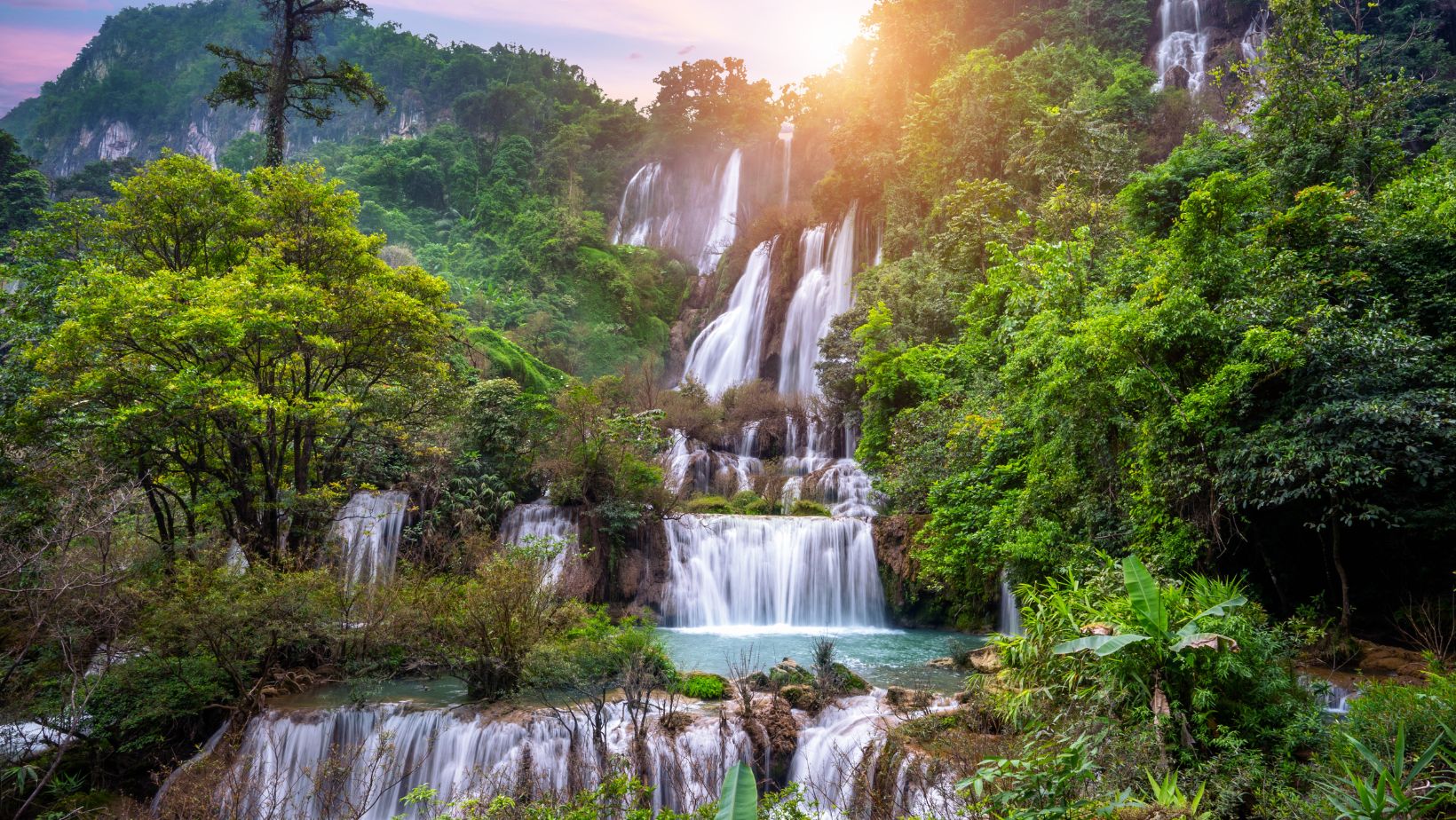Discover Thailand’s most stunning waterfalls! A fun guide for first-time travellers and expats on where to go, when to visit, and how to explore. This guide will help you plan smart, stay safe, and get all the joy out of your waterfall adventures.
Why Waterfalls Are a Must for First-Time Travellers & Expats
-
Cool down anywhere: Perfect for escaping heat and humidity on hot Thai days.
-
Nature immersion: Jungle trails, serene pools, wildlife, fresh air – a reset button for the senses.
-
Photography & memory-making: Mist, cascading water, light filtering through leaves… perfect for the ‘gram (or just for your mental photo album).
-
Affordable adventure: Modest entry fees, local food, and transport make it great value travel.
Top Waterfalls You Can’t Miss (and Why)
Here are a few of Thailand’s standout waterfalls for first-time nature seekers and expats.
| Waterfall | Location | What Makes It Special | Best Time to Visit |
|---|---|---|---|
| Erawan Waterfall | Kanchanaburi | Seven tiers of turquoise pools, well-maintained trails, good for both swimming and hiking. Great for day trips from Bangkok. | Dry season (November–April) for clearer water & safer trails; early morning to beat crowds. |
| Huay Mae Khamin | Kanchanaburi | Less crowded, very lush, beautiful multi-tier falls. Feels more “off the beaten path.” | December-April for easy walks and calm water; avoid extreme wet (muddy, slippery) days. |
| Mae Ya Waterfall | Chiang Mai / Doi Inthanon | One of the tallest and widest in northern Thailand; dramatic flow and scenic setting. | Best between November-February; rainy season gives big flow but trails get tricky. |
| Thi Lo Su | Tak Province | Massive, powerful, wild. This is for when you want to get deep into nature. | Peak during rainy season (July-November) when flow is most impressive. |
| Na Muang Waterfalls | Ko Samui | Sweet combo of jungle ambience + beach-island vibe. Two main falls; good for swimming & relaxation. | Dry season (December-February) is ideal, though after rains the falls are more dramatic. |
When to Go: Seasons & Weather Tips
Thailand has three main seasons: hot, rainy (monsoon), and cool/dry.
| Season | Pros for Waterfalls | Things to Watch Out For |
|---|---|---|
| Rainy (May-October) | Waterfalls are fullest & most dramatic; lush green surroundings. | Trails get muddy/slippery; safety risk from flash floods. |
| Cool/Dry (November-February) | Best for hiking, clearer water, cooler weather; fewer mosquitoes. | Water flow may be less in some waterfalls. |
| Hot Season (March-April) | Less crowded at some places; sunrise/sunset photography is good. | It’s very hot; some falls may have very low flow. |
Preparing for the Trip: Gear + Logistics
-
Footwear: Water-friendly shoes with grip (water sandals, trail shoes) are essential.
-
Swimwear & change clothes: Some parks have changing rooms at lower tiers; higher tiers may not.
-
Sun protection & insect repellent: Shade can be limited; mosquitoes are active near water.
-
Water & snacks: Bring enough drinking water; some parks have limited vendors.
-
Dry bag or waterproof pouch for phone, camera, valuables.
-
Cash: Entry fees, parking, or small rentals. Remote parks may not take cards.
-
Arrive early: Parks often open around 8 am; arriving early means cooler weather and fewer crowds.
Etiquette, Safety, & Respecting Nature
-
Follow park rules: Stay within marked areas and respect safety signs.
-
No littering: Carry out everything you bring in. Use reusable bottles where possible.
-
Respect wildlife: Don’t feed monkeys or fish.
-
Safety first: Trails can be steep and slippery; avoid swimming after heavy rains.
-
Cultural respect: Dress modestly in shared spaces, even at natural attractions.
Sample 3-Day Itinerary (If You’re Based in Bangkok or Chiang Mai)
Option A: Bangkok → Kanchanaburi
-
Day 1: Travel to Kanchanaburi. Explore the town and River Kwai.
-
Day 2: Full day at Erawan Waterfalls. Swim, hike, relax.
-
Day 3: Optional side trip to Huay Mae Khamin, or unwind in Kanchanaburi before heading back.
Option B: Chiang Mai → Doi Inthanon
-
Day 1: Travel to Doi Inthanon area. Stay nearby.
-
Day 2: Visit Mae Ya Waterfall and nearby natural sites.
-
Day 3: Explore local villages or markets before returning to Chiang Mai.
FAQs for First-Timers & Expats
| Question | Short Answer |
|---|---|
| Is English okay? | Yes. Tourist spots usually have signs in English. |
| Should I hire a guide? | Not required for popular falls, but useful for remote ones. |
| Is it safe to swim? | Yes, in designated spots. Avoid during heavy rains. |
| Transport options? | Public buses, minivans, rental cars, or tours depending on location. |
| How to avoid crowds? | Go early in the morning, on weekdays, and avoid Thai holidays. |
Final Thoughts: Embrace the Adventure
For first-time travellers and expats, chasing waterfalls in Thailand is about more than just the photos. It’s about stepping into lush nature, feeling the spray on your face, hearing the jungle come alive, and creating memories that go far beyond the ordinary trip.
Take more than just pictures: take the moment with you.
Safe travels & happy waterfall chasing!



